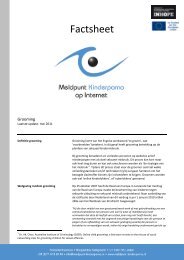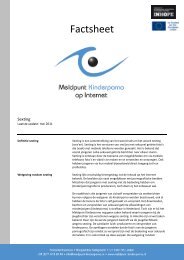efforts with respect to child pornography images are mostly reactive. As some pipelineproviders explained to <strong>the</strong> Subcommittee, <strong>the</strong> primary way <strong>the</strong>y disc<strong>over</strong> childpornography images on <strong>the</strong>ir networks is by customer reports or complaints, which <strong>the</strong>pipeline provider <strong>the</strong>n forwards to NCMEC. Pipeline providers also respond to lawenforcement agents’ requests and subpoenas for customer information.In addition to <strong>the</strong>ir proactive measures, <strong>the</strong> Internet Service Providers also explained<strong>the</strong>ir data retention policies and addressed <strong>the</strong> announcement <strong>of</strong> <strong>the</strong> Department <strong>of</strong> Justicethat it intended to explore with ISPs establishing a uniform data retention policy for <strong>the</strong>purpose <strong>of</strong> enhancing law enforcement’s investigations <strong>of</strong> Internet child pornography. 17As discussed previously, law enforcement agents who testified at <strong>the</strong> Subcommittee’sApril and May hearings explained that inadequate data retention policies had prevented<strong>the</strong>m in some cases from identifying individuals who create or distribute childpornography images <strong>over</strong> <strong>the</strong> Internet.While all <strong>the</strong> Internet Service Providers testified that <strong>the</strong>y report images <strong>of</strong> apparentchild pornography to NCMEC when <strong>the</strong>y disc<strong>over</strong> it on <strong>the</strong>ir networks and that <strong>the</strong>yattempt to respond to law enforcement agents’ requests and subpoenas as expeditiously aspossible, <strong>the</strong> data retention policies <strong>of</strong> <strong>the</strong> ISPs that testified at <strong>the</strong> hearing vary widely,from 60 days to seven years. Testimony provided at <strong>the</strong> hearing suggests that <strong>the</strong> cost <strong>of</strong>data retention is a determining factor in setting <strong>the</strong> retention period. AOL, for example,testified that retaining <strong>the</strong> IP addresses for each user session <strong>of</strong> every AOL user wouldcost $44 million per year. Several factors have a bearing on <strong>the</strong> cost, for example, <strong>the</strong>types <strong>of</strong> services <strong>of</strong>fered by <strong>the</strong> provider, <strong>the</strong> number <strong>of</strong> users, and whe<strong>the</strong>r <strong>the</strong> site is freeor available only to paid subscribers. However, law enforcement <strong>of</strong>ficials have stressedthat it is <strong>the</strong> ISPs that provide connectivity to <strong>the</strong> Internet which need to retain IPaddresses for at least one year for purposes <strong>of</strong> child pornography investigations.The operations <strong>of</strong> social networking websites were also examined at <strong>the</strong> June hearing.These websites have become increasingly popular in recent years, especially amongpreteens, teenagers and young adults. Registered users with social networking websitesare able to build personal webpages. These webpages <strong>of</strong>ten contain personal informationabout <strong>the</strong> user, such as where he or she attends school or works, <strong>the</strong>ir likes and dislikes,links to <strong>the</strong>ir friends’ webpages or o<strong>the</strong>r websites, contact information, and photographs.Recently, social networking websites have received a great deal <strong>of</strong> scrutiny as childpredators have used <strong>the</strong> information on <strong>children</strong>’s webpages to contact <strong>the</strong>m and togroom <strong>the</strong>m in anticipation <strong>of</strong> meeting <strong>the</strong>m in person. Facebook, MySpace, and Xangatestified about <strong>the</strong> safeguards <strong>the</strong>y have implemented on <strong>the</strong>ir websites. 18 Users <strong>of</strong> each17 At <strong>the</strong> time <strong>of</strong> <strong>the</strong> hearing, AOL retained <strong>the</strong> data that links an IP address to a customer’s name for 90days; Earthlink for seven years; Comcast for 180 days; Verizon for nine months.18 At <strong>the</strong> time <strong>of</strong> <strong>the</strong> hearing, MySpace had 80 million registered users; Xanga had 27 million; and Facebookhad more than 8 million. While Facebook, MySpace, and Xanga are each social networking websites, <strong>the</strong>yoperate differently with respect to how users can obtain access to <strong>the</strong> website. MySpace and Xanga areopen to <strong>the</strong> general public. Anyone with Internet access can open a MySpace or Xanga account and build apersonal webpage. In contrast, to join Facebook, a user must be validated into one <strong>of</strong> Facebook’s onlinecommunities. The communities are largely organized by high schools and colleges, but <strong>the</strong>re are also work22
website have <strong>the</strong> option <strong>of</strong> making <strong>the</strong>ir pr<strong>of</strong>iles private, <strong>the</strong>reby preventing o<strong>the</strong>r usersfrom viewing <strong>the</strong>ir personal webpage. On MySpace, <strong>the</strong> “private” setting is <strong>the</strong> defaultsetting for any user who admits to being under <strong>the</strong> age <strong>of</strong> 16 years. Xanga 19 employssimilar features which allow a user to restrict <strong>the</strong>ir webpage to only o<strong>the</strong>r Xangamembers or to o<strong>the</strong>r designated users, respectively. Xanga has also developed a safetyfeature, called “Footprints,” which, when activated, allows a Xanga member to see <strong>the</strong>usernames <strong>of</strong> individuals who have signed into his or her webpage. Similarly, Facebook<strong>of</strong>fers a privacy option which permits <strong>the</strong> user to determine who can see particular pieces<strong>of</strong> information about <strong>the</strong>m, including <strong>the</strong>ir entire webpage.In addition to <strong>of</strong>fering a privacy setting, <strong>the</strong> social networking websites who testifiedat <strong>the</strong> June hearing allow <strong>the</strong>ir users to report inappropriate content by clicking on linksor tabs displayed on <strong>the</strong> user webpages. Typically, <strong>the</strong>se reports are sent first to <strong>the</strong>website itself, so that website employees can review <strong>the</strong> reports and take appropriateaction, including terminating <strong>the</strong> account <strong>of</strong> a user who has violated <strong>the</strong> terms andconditions <strong>of</strong> <strong>the</strong> website. If <strong>the</strong> content contained apparent images <strong>of</strong> child pornographyor grooming, each website stated that <strong>the</strong>y report this activity to NCMEC. 20The social networking websites also conduct some human and automated review <strong>of</strong><strong>the</strong> content on <strong>the</strong>ir webspages, however, more needs to be done to ensure that <strong>the</strong>senetworks. In order to be validated, a potential user must have ei<strong>the</strong>r a “.edu” email address or similarassociated with a school or university email domain or, if a high school does not have a domain, highschool users can join if <strong>the</strong>y receive an invitation from a college user who graduated from that high school.The high school user who received <strong>the</strong> invitation will <strong>the</strong>n invite o<strong>the</strong>r students from his high school tojoin; to ensure that individuals who do not have a .edu domain name are, in fact, students at a particularhigh school, Facebook places a computer code within <strong>the</strong> invitation email that confirms <strong>the</strong> individual whojoined was <strong>the</strong> same individual who received <strong>the</strong> invitation. Additionally, members <strong>of</strong> Facebook only haveaccess to <strong>the</strong> pr<strong>of</strong>iles <strong>of</strong> members within <strong>the</strong>ir school community. In this way, Facebook users only haveaccess to <strong>the</strong>ir school communities. To view <strong>the</strong> pr<strong>of</strong>ile <strong>of</strong> a user outside that community, Facebookmembers must receive permission from that user. Members <strong>of</strong> work communities only have access to <strong>the</strong>pr<strong>of</strong>iles <strong>of</strong> o<strong>the</strong>r users who have joined <strong>the</strong> same regional network <strong>the</strong>y have joined. As MySpace andXanga are not organized according to work, school, or regional communities, MySpace and Xanga usershave access to any o<strong>the</strong>r webpage on <strong>the</strong> website, unless a user has activated a privacy setting that limitsaccess to approved MySpace or Xanga users.19 On September 7, 2006, <strong>the</strong> Federal Trade Commission (“FTC”) announced that it had reached asettlement with Xanga related to Xanga’s alleged violations <strong>of</strong> <strong>the</strong> Children’s Online Privacy ProtectionAct (“COPPA”). The FTC found that Xanga, in violation <strong>of</strong> COPPA, had improperly collected, used, anddisclosed personal information from <strong>children</strong> under <strong>the</strong> age <strong>of</strong> 13 without first notifying <strong>the</strong>ir parents andobtaining consent. Under <strong>the</strong> settlement, Xanga paid a $1 million fine to <strong>the</strong> FTC.20 NCMEC is <strong>the</strong> designated repository in <strong>the</strong> United States <strong>of</strong> all reports <strong>of</strong> online grooming or child<strong>sexual</strong> abuse or <strong>exploitation</strong>, and <strong>the</strong>ir link is displayed on several websites in order for users to reportabuse. Once a report is received by NCMEC, analysts are available 24 hours a day to review <strong>the</strong> report andforward it to <strong>the</strong> appropriate law enforcement agency. O<strong>the</strong>r countries have adopted similar approaches.For example, in <strong>the</strong> United Kingdom and Australia, many websites display a link to <strong>the</strong> Virtual GlobalTaskforce, or VGT. The VGT is comprised <strong>of</strong> law enforcement agents from Australia, <strong>the</strong> U.K., Canada,and <strong>the</strong> U.S., where agents from ICE are members. Internet users can report grooming or online <strong>sexual</strong>abuse by clicking on <strong>the</strong> VGT button, or link, displayed on social networking websites or <strong>the</strong> VGT’swebsite, www.virtualglobaltaskforce.com. The link <strong>the</strong>n takes <strong>the</strong> user to a reporting page, where he or sheis asked to supply certain information such as <strong>the</strong> webpage where <strong>the</strong> abuse occurred. The report is <strong>the</strong>nimmediately sent to <strong>the</strong> appropriate country for immediate review and action by law enforcement.23















